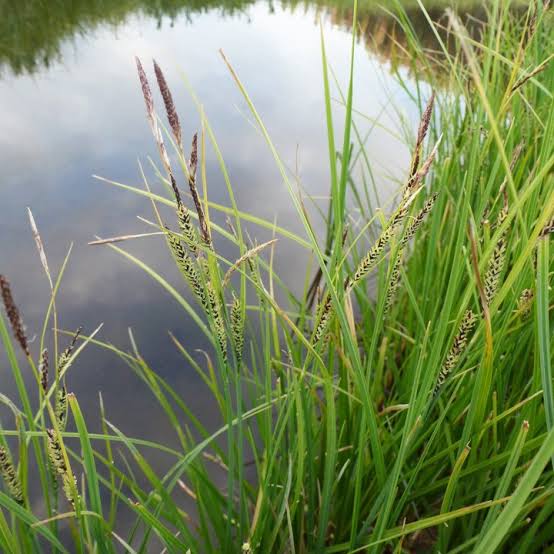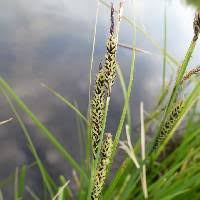Water sedge (Carex aquatilis) is a plant that lives in water. It likes to be in wet places, such as ponds, lakes, and rivers. This plant has long, green leaves that look like grass. People sometimes call it water grass because of its appearance.
Water sedge is special because it helps in keeping the water clean. Its roots go into the water and act like a filter. They take out bad things from the water, making it better for other living things in the water. This is good for the environment.
Many animals like to live near water sedge. Bugs, frogs, and small fish find it a good place to stay. It gives them shelter and protection. Birds also like to visit water sedge areas. They find insects and small creatures to eat, making it a helpful spot for the whole ecosystem.
In the spring, water sedge makes small flowers. They are not big or colorful like some flowers, but they play a role in making seeds. These seeds help the plant spread to new places. It’s like water sedge is growing its family in different places.
People can use water sedge in gardens near water. It can help prevent soil erosion and keep the water clean. Some people also like the way it looks, adding a natural touch to their surroundings. Taking care of water sedge is simple; it mostly takes care of itself.
In addition, water sedge (Carex aquatilis) is a wonderful plant that loves to live in water. It helps the environment by cleaning the water and providing a home for various animals. With its simple beauty, it adds a touch of nature to the places it grows. Water sedge is not just a plant; it’s a helper in the circle of life near water.
Read Also: How to Grow Passion Fruits (Passiflora edulis) and make Fortune from it
How To Grow Water Sedge (Carex aquatilis)

Growing water sedge (Carex aquatilis) can be a rewarding experience. Here’s a simple guide on how to grow this aquatic plant:
1. Choose the Right Location: Select a spot that stays wet or has access to water, like the edge of a pond, lake, or a moist area in your garden. Water sedge thrives in damp conditions, so it’s crucial to mimic its natural habitat.
2. Soil Preparation: Ensure the soil is rich in organic matter and well-draining. Water sedge doesn’t like to sit in waterlogged soil for too long. Mixing in compost can improve the soil structure.
3. Planting: Place the water sedge in the chosen location. Gently press it into the soil, making sure the roots are covered but not buried too deeply. Plant during the spring or fall for optimal growth.
4. Watering: Keep the soil consistently moist, especially during the growing season. Water sedge prefers damp conditions, so regular watering is essential. If you’re planting near a water source, periodic flooding is natural and beneficial.
5. Sunlight: Water sedge can tolerate both full sun and partial shade. However, in hotter regions, providing some shade during the hottest parts of the day can be beneficial.
6. Fertilizing: Water sedge generally doesn’t require a lot of fertilizers. If your soil lacks nutrients, you can use a balanced, slow-release fertilizer in the spring. Avoid over-fertilizing, as this can lead to excessive growth.
7. Maintenance: Once established, water sedge is relatively low-maintenance. Trim any dead or damaged leaves to keep the plant looking tidy. If it starts spreading too much, dividing the plant every few years can help maintain its health.
8. Wildlife Attraction: Embrace the wildlife attracted to water sedge. Frogs, insects, and birds may make your garden their home. This is a positive sign that your water sedge is contributing to the local ecosystem.
9. Propagation: Water sedge can be propagated by dividing established clumps. This is best done in early spring or fall. Lift the plant, separate the clumps, and replant them in suitable locations.
10. Enjoy the Beauty: Watch as water sedge grows and contributes to the natural beauty of your garden. Observe the subtle flowers it produces and appreciate its role in supporting local biodiversity.
Remember, growing water sedge is about creating a thriving ecosystem in and around water. By providing the right conditions, you can enjoy the benefits of this versatile and helpful plant.
How To Care For Water Sedge (Carex aquatilis)
Caring for water sedge (Carex aquatilis) involves some simple steps to ensure it thrives in its aquatic environment:
1. Watering: Keep the soil consistently moist, as water sedge naturally grows in wet conditions. Regular watering is essential, especially during dry periods. However, avoid waterlogging, as this can lead to root rot.
2. Sunlight: Water sedge can tolerate both full sun and partial shade. However, in hotter climates, providing some shade during the hottest parts of the day can prevent stress on the plant.
3. Soil: Ensure the soil is well-draining and rich in organic matter. Periodically check the soil for compacted areas and aerate if necessary to maintain a healthy root system.
4. Pruning: Trim any dead or damaged leaves to keep the plant looking neat. Water sedge generally doesn’t require extensive pruning, but removing yellow or brown foliage can promote new growth.
5. Fertilizing: Water sedge is not heavy feeder, but if your soil lacks nutrients, you can use a balanced, slow-release fertilizer in the spring. Avoid over-fertilizing, as this can lead to excessive growth.
6. Wildlife Interaction: Embrace the wildlife that water sedge attracts. Frogs, insects, and birds may find refuge in and around the plant. Avoid using harmful pesticides that could harm the beneficial creatures.
7. Division: If the water sedge becomes too dense, consider dividing the plant every few years. This involves lifting the plant, separating the clumps, and replanting them in suitable locations. This helps maintain the plant’s health and vigor.
8. Flooding Tolerance: If your water sedge is planted in an area prone to occasional flooding, it’s generally well-tolerant. Just ensure that the flooding is not prolonged, as extended submersion can stress the plant.
9. Mulching: Apply a layer of organic mulch around the base of the water sedge to help retain moisture, suppress weeds, and regulate soil temperature.
10. Monitor for Pests and Diseases: Keep an eye out for any signs of pests or diseases. While water sedge is generally resilient, pests like aphids or diseases like fungal infections can occur. Promptly address any issues to maintain the plant’s health.
By following these care tips, you can encourage the growth of water sedge and enjoy its benefits in your aquatic garden or landscape. Remember that this plant contributes to the local ecosystem, so creating a harmonious environment is key to its well-being.
Read Also: How to increase Passion Fruit Yields
The Uses of Water Sedge (Carex aquatilis)

Water sedge (Carex aquatilis) has several ecological and practical uses:
1. Erosion Control: The extensive root system of water sedge helps stabilize soil along water bodies, preventing erosion. Planting water sedge in areas prone to soil loss can be an effective natural solution.
2. Water Filtration: Water sedge acts as a natural water filter. Its roots absorb nutrients and contaminants from the water, improving water quality. This is particularly valuable in maintaining healthy aquatic ecosystems.
3. Habitat for Wildlife: Water sedge provides habitat and shelter for various wildlife. Insects, amphibians, and birds are attracted to the plant, making it an essential component of wetland ecosystems.
4. Aesthetic Value: Many people appreciate water sedge for its simple, grass-like appearance. It can enhance the visual appeal of water features in gardens and landscapes, contributing to a natural and serene atmosphere.
5. Wetland Restoration: Water sedge is often used in wetland restoration projects. Planting it in degraded wetland areas helps recreate natural ecosystems and promotes biodiversity.
6. Soil Improvement: As water sedge grows, it contributes organic matter to the soil. This organic matter improves soil structure, fertility, and moisture retention, benefiting the surrounding plant life.
7. Stormwater Management: In areas prone to stormwater runoff, water sedge can help manage water flow. Its ability to absorb excess water can reduce the risk of flooding and control the movement of water in waterlogged areas.
8. Educational Purposes: Water sedge is used in educational settings to teach about wetland ecosystems, water purification, and the importance of native plants in supporting local biodiversity.
9. Aquatic Gardens: Gardeners often use water sedge in aquatic gardens or around ponds. Its adaptable nature and ability to thrive in damp conditions make it a suitable choice for landscaping around water features.
10. Traditional Uses: In some cultures, water sedge may have traditional uses. This can include medicinal or practical applications based on local knowledge and practices.
Understanding and appreciating the multifaceted uses of water sedge can lead to more intentional and sustainable landscaping practices, especially in areas near water bodies or wetland environments.
Frequently Asked Questions (FAQs)
Q: What are the ideal growing conditions for water sedge?
A: Water sedge thrives in damp conditions, such as along pond edges or in wetland areas. It prefers well-draining soil rich in organic matter.
Q: How often should I water water sedge?
A: Keep the soil consistently moist. Regular watering, especially during dry periods, is crucial. However, avoid waterlogging to prevent root rot.
Q: Can water sedge tolerate full sun?
A: Yes, water sedge can tolerate both full sun and partial shade. In hotter climates, providing some shade during the hottest parts of the day can be beneficial.
Q: How do I propagate water sedge?
A: Water sedge can be propagated by dividing established clumps. This is best done in early spring or fall. Lift the plant, separate the clumps, and replant them in suitable locations.
Q: Is fertilizing necessary for water sedge?
A: Water sedge is not a heavy feeder. If your soil lacks nutrients, you can use a balanced, slow-release fertilizer in the spring. Avoid over-fertilizing to prevent excessive growth.
Q: Does water sedge attract wildlife?
A: Yes, water sedge provides habitat for various wildlife, including insects, amphibians, and birds. Embracing the wildlife attracted to it is part of its ecological benefit.
Q: Can water sedge be used for erosion control?
A: Yes, the extensive root system of water sedge makes it effective for stabilizing soil along water bodies, preventing erosion.
Q: How do I care for water sedge in flooded areas?
A: Water sedge is generally tolerant of periodic flooding. However, avoid prolonged submersion, as it can stress the plant.
Q: When should I prune water sedge?
A: Trim any dead or damaged leaves as needed to keep the plant looking neat. Water sedge generally doesn’t require extensive pruning.
Q: What is the aesthetic value of water sedge?
A: Many people appreciate water sedge for its simple, grass-like appearance. It can enhance the visual appeal of water features in gardens and landscapes.
Read Also: How to Build a Raised Bed Garden
